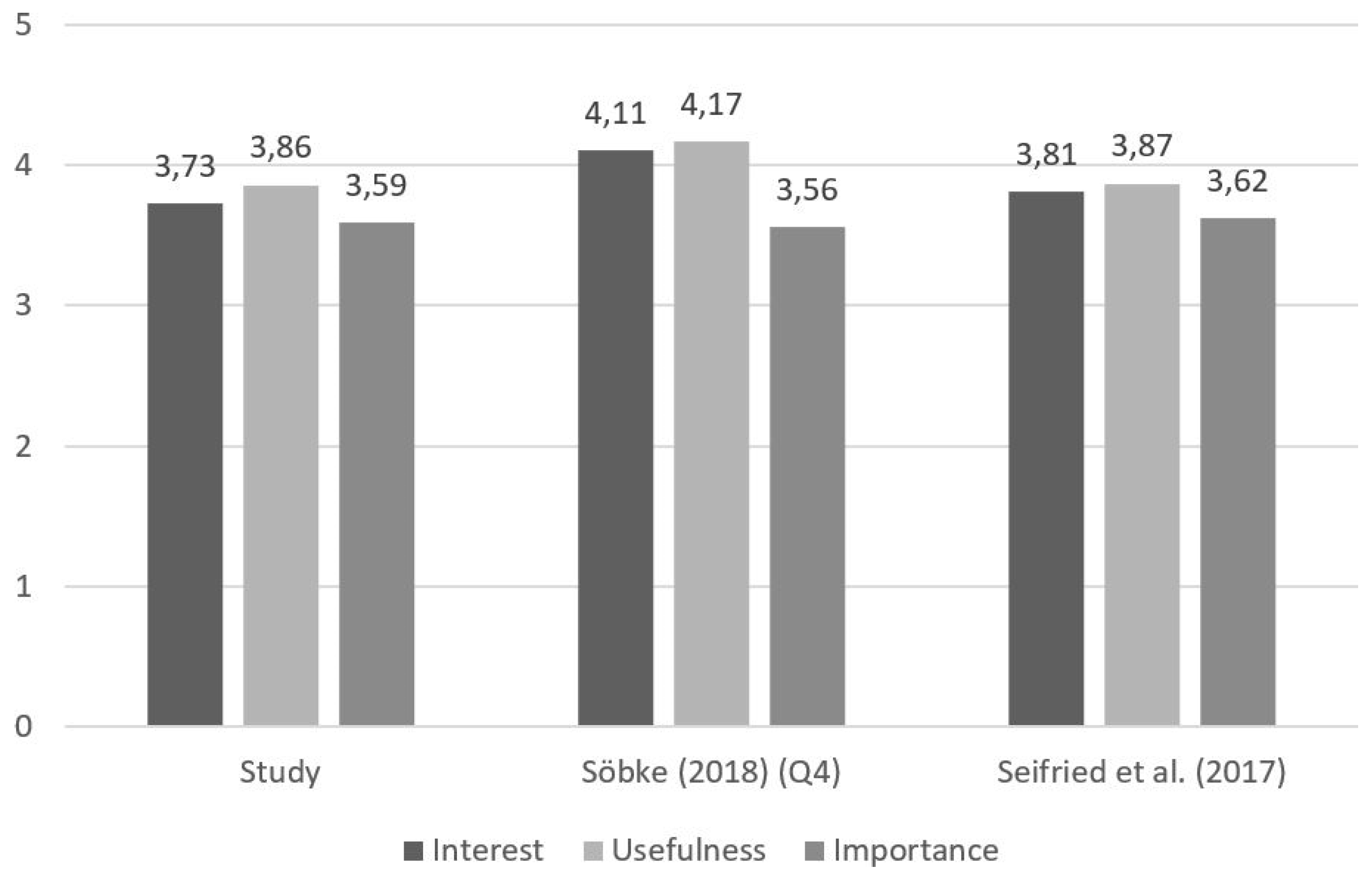SimCity in Infrastructure Management Education
Abstract
1. Introduction
2. Didactical Scenario
2.1. Background
2.2. Implementation of the Nohra Simulation Scenario in SimCity
2.3. Structure of the Course and Embedding of the SimCity Didactic Scenario
3. Research Goals and Methodology
4. Results
4.1. Demographics
4.2. Obersvations
4.3. Motivation
4.3.1. General Motivation
4.3.2. Game Experience
4.3.3. Current Motivation in Learning Situations
4.3.4. Correlations
4.4. Didactic Scenario
4.5. Learning
4.6. Game Aging
5. Discussion
6. Conclusions
Author Contributions
Funding
Conflicts of Interest
References
- Squire, K.R. Video Games in Education. Int. J. Intell. Simul. Gaming 2003, 2, 49–62. [Google Scholar] [CrossRef]
- Abt, C.C. Serious Games; University Press of America: Lanham, MD, USA, 1987. [Google Scholar]
- Gee, J.P. What Video Games Have to Teach US about Learning and Literacy; Palgrave Macmillan: New York, NY, USA, 2008. [Google Scholar]
- Mayer, R.E. What Should Be the Role of Computer Games in Education? Policy Insights Behav. Brain Sci. 2006, 3, 20–26. [Google Scholar] [CrossRef]
- Brünken, R.; Plass, J.L.; Moreno, R. Current Issues and Open Questions in Cognitive Load Research. In Cognitive Load Theory; Plass, J.L., Moreno, R., Brünken, R., Eds.; Cambridge University Press: Cambridge, UK, 2010; pp. 253–272. [Google Scholar]
- Dörner, D. Über die Schwierigkeiten menschlichen Umgangs mit Komplexität. Psychol. Rundsch. 1981, 7, 163–179. [Google Scholar]
- Foster, A.N. The process of learning in a simulation strategy game: Disciplinary knowledge construction. J. Educ. Comput. Res. 2011, 45, 1–27. [Google Scholar] [CrossRef]
- Rehm, M. Do gamers change attitudes towards economics through playing manager games? Zeitschrift für Ökonomische Bild 2013, 1, 162–176. [Google Scholar]
- Pasin, F.; Giroux, H. The Impact of a Simulation Game on Operations Management Education. Comput. Educ. 2011, 57, 1240–1254. [Google Scholar] [CrossRef]
- Moreno-Ger, P.; Burgos, D.; Ortiz, I.M.; Sierra, J.L.; Manjón, B.F. Educational game design for online education. Comput. Hum. Behav. 2008, 24, 2530–2540. [Google Scholar] [CrossRef]
- Söbke, H.; Bröker, T.; Kornadt, O. Using the Master Copy—Adding Educational Content to Commercial Video Games. In Proceedings of the 7th European Conference on Games-Based Learning, Porto, Portogal, 3–4 October 2013; De Carvalho, C.V., Escudeiro, P., Eds.; Academic Conferences and Publishing International Limited: Reading, UK, 2013; Volume 2, pp. 521–530. [Google Scholar]
- D’Artista, B.R.; Hellweger, F.L. Urban hydrology in a computer game? Environ. Model. Softw. 2007, 22, 1679–1684. [Google Scholar] [CrossRef]
- Charsky, D.; Mims, C. Integrating Commercial Off-the-Shelf Video Games into School Curriculums. TechTrends 2008, 52, 38–44. [Google Scholar]
- Bereitschaft, B. Gods of the City? Reflecting on City Building Games as an Early Introduction to Urban Systems. J. Geogr. 2016, 115, 51–60. [Google Scholar] [CrossRef]
- Devisch, O. Should Planners Start Playing Computer Games? Arguments from SimCity and Second Life. Plan. Theory Pract. 2008, 9, 209–226. [Google Scholar] [CrossRef][Green Version]
- Rufat, S.; Ter Minassian, H. Video games and urban simulation: New tools or new tricks? Cybergeo Eur. J. Geogr. 2012. [Google Scholar] [CrossRef]
- Boyle, E.A.; Hainey, T.; Connolly, T.M.; Gray, G.; Earp, J.; Ott, M.; Lim, T.; Ninaus, M.; Ribeiro, C.; Pereira, J. An update to the systematic literature review of empirical evidence of the impacts and outcomes of computer games and serious games. Comput. Educ. 2016, 94, 178–192. [Google Scholar] [CrossRef]
- Harteveld, C.; Guimarães, R.; Mayer, I.; Bidarra, R. Balancing pedagogy, game and reality components within a unique serious game for training levee inspection. Technol. E-Learn. Digit. Entertain. 2007, 128–139. [Google Scholar] [CrossRef]
- Wright, W. SimCity. Available online: www.simcity.com (accessed on 12 June 2017).
- Juraschek, M.; Herrmann, C.; Thiede, S. Utilizing Gaming Technology for Simulation of Urban Production. Procedia CIRP 2017, 61, 469–474. [Google Scholar] [CrossRef]
- Gaberdan, E.; Maier, K.; Söbke, H.; Londong, J. Illustrating decisions to end-users: The case of agent-based simulation for stormwater management. In Proceedings of the Computational Methods in Water Resources 2014 International Conference, Stuttgart, Germany, 10–13 June 2014; University of Stuttgart: Stuttgart, Germany, 2014. [Google Scholar]
- Gee, J.P. Deep learning properties of good digital games: How far can they go. In Serious Games: Mechanisms and Effects; Ritterfeld, U., Cody, M., Vorderer, P., Eds.; Routledge: New York, NY, USA, 2009; pp. 89–104. [Google Scholar]
- Poplin, A. Digital serious game for urban planning: “B3-Design your Marketplace!”. Environ. Plan. B 2014, 41, 493–511. [Google Scholar] [CrossRef]
- Lobo, D. A city is not a toy: How SimCity plays with urbanism. In Cities Programme: Architecture and Engineering; London School of Economics and Political Science: London, UK, 2005. [Google Scholar]
- Arnold, U.; Datta, B.; Haenscheid, P. Intelligent geographic information systems (IGIS) and surface water modeling. In Proceedings of the Baltimore Symp.: New Directions for Surface Water Modeling, Baltimore, CD, USA, 10–19 May 1989; pp. 407–416. [Google Scholar]
- Hanzl, M. Information technology as a tool for public participation in urban planning: A review of experiments and potentials. Des. Stud. 2007, 28, 289–307. [Google Scholar] [CrossRef]
- Klopfer, E.; Osterweil, S.; Salen, K.; Groff, J.; Roy, D. Moving Learning Games Forward; Massachusetts Institute of Technology, The Education Arcade: Cambridge, MA, USA, 2009. [Google Scholar]
- Kafai, Y.B.; Burke, Q. Constructionist Gaming: Understanding the Benefits of Making Games for Learning. Educ. Psychol. 2015, 50, 313–334. [Google Scholar] [CrossRef]
- Friedman, T. The semiotics of SimCity. First Monday 1999, 4, 4. [Google Scholar] [CrossRef]
- Koster, R. Theory of Fun for Game Design; Paraglyph Press: Scottsdale, AZ, USA, 2004. [Google Scholar]
- Becker, K.; Gopin, E. Selection criteria for using commercial off the shelf games (COTS) for learning. In Learning, Education and Games. Volume two: Bringing Games into Educational Contexts; Schrier, K., Ed.; ETC Press: Halifax, NS, Canada, 2016; pp. 43–60. ISBN 978-1329703568. [Google Scholar]
- Van Eck, R. A Guide to Integrating COTS Games into Your Classroom. In Handbook of Research on Effective Electronic Gaming in Education; IGI Global: Pennsylvania, PA, USA, 2009; pp. 179–199. [Google Scholar] [CrossRef]
- Gaber, J. Simulating Planning: SimCity as a Pedagogical Tool. J. Plan. Educ. Res. 2007, 27, 113–121. [Google Scholar] [CrossRef]
- Woessner, M. Teaching with SimCity: Using Sophisticated Gaming Simulations to Teach Concepts in Introductory American Government. PS Political Sci. Politics 2015, 48, 358–363. [Google Scholar] [CrossRef]
- Squire, K.R. Video Games and Learning: Teaching and Participatory Culture in the Digital Age; Teachers College Press: New York, NY, USA, 2011. [Google Scholar]
- Javier, R.T. Modeling and Simulating the City: Deciphering the Code of a Game of Strategy. Int. J. Archit. Comput. 2007, 5, 571–586. [Google Scholar] [CrossRef]
- Tanes, Z.; Cemalcilar, Z. Learning from SimCity: An empirical study of Turkish adolescents. J. Adolesc. 2010, 33, 731–739. [Google Scholar] [CrossRef]
- Minnery, J.; Searle, G. Toying with the City? Using the Computer Game SimCity 4 in Planning Education. Plan. Pract. Res. 2013, 29, 41–55. [Google Scholar] [CrossRef]
- Terzano, K.; Morckel, V. SimCity in the Community Planning Classroom: Effects on Student Knowledge, Interests, and Perceptions of the Discipline of Planning. J. Plan. Educ. Res. 2016, 37, 95–105. [Google Scholar] [CrossRef]
- Adams, P.C. Teaching and Learning with SimCity 2000. J. Geogr. 1998, 97, 47–55. [Google Scholar] [CrossRef]
- Kim, M.; Shin, J. The Pedagogical Benefits of SimCity in Urban Geography Education. J. Geogr. 2015, 115, 39–50. [Google Scholar] [CrossRef]
- Betz, J.A. Computer games: Increase learning in an interactive multidisciplinary environment. J. Educ. Technol. Syst. 1995, 24, 195–205. [Google Scholar] [CrossRef]
- McCue, C.; James, D. Future Cities Engineering: Early Engineering Interventions in the Middle Grades. Adv. Eng. Educ. 2008, 1, n2. [Google Scholar]
- Nilsson, E.M.; Jakobsson, A. Simulated Sustainable Societies: Students’ Reflections on Creating Future Cities in Computer Games. J. Sci. Educ. Technol. 2011, 20, 33–50. [Google Scholar] [CrossRef]
- Yang, Y.-T.C. Building virtual cities, inspiring intelligent citizens: Digital games for developing students’ problem solving and learning motivation. Comput. Educ. 2012, 59, 365–377. [Google Scholar] [CrossRef]
- Monjelat, N.; Méndez Zaballos, L.; Lacasa, P. Problem solving processes and video games: The Sim City Creator case. Electron. J. Res. Educ. Psychol. 2012, 3, 1493–1522. [Google Scholar]
- Resick, C.J.; Murase, T.; Randall, K.R.; DeChurch, L.A. Information elaboration and team performance: Examining the psychological origins and environmental contingencies. Organ. Behav. Hum. Decis. Process. 2014, 124, 165–176. [Google Scholar] [CrossRef]
- Lacasa, P.; Martinez, R.; Mendez, L. Developing new literacies using commercial videogames as educational tools. Linguist. Educ. 2008, 19, 85–106. [Google Scholar] [CrossRef]
- Glamus GmbH Mobility—A City in Motion! Available online: http://www.mobility-online.de (accessed on 15 October 2017).
- Brannolte, U.; Harder, R.J.; Kraus, T.J. Virtual City and Traffic Simulation Game Based on Scientific Models. In Proceedings of the 6th EUROSIM Congress on Modelling and Simulation, EUROSIM 2007, Ljubljana, Slovenia, 9–13 September 2007; Zupančič, B., Karba, R., Blažič, S., Eds.; Argesim: Vienna, Austria, 2007; Volume 1. [Google Scholar]
- Harder, R. Simulation of a Mobility-Related Network of Interactions; Poznan University of Technology, Institute of Working Machines and Motor-Vehicles: Poznan, Poland; Krakow, Poland, 1999. [Google Scholar]
- Söbke, H.; Harder, R.; Plank-Wiedenbeck, U. Two Decades of Traffic System Education Using the Simulation Game MOBILITY. In Proceedings of the Serious Games 4th Joint International Conference, JCSG 2018, Darmstadt, Germany, 7–8 November 2018; Göbel, S., Garcia-Agundez, A., Tregel, T., Ma, M., Baalsrud Hauge, J., Oliveira, M., Marsh, T., Caserman, P., Eds.; Springer International Publishing: Cham, Switzerland, 2018; pp. 43–53. [Google Scholar]
- Haupt, T.; Arnold, U.; Bidlingmaier, W. Studien- und hochschulübergreifender Einsatz einer engl.-spr. multimedialen Urban Infrastructure Development Simulation in der akademischen Aus- und Weiterbildung—MUrIDS (Cross-study and cross-university use of an English multimedia Urban Infrastructure Development Simulation in academic education—MUrIDS). In Proceedings of the Tagungsband 9. Workshop: Multimedia in Bildung und Wirtschaft—Einsatz und Nachhaltigkeit von eLearning, Ilmenau, Germany, 22–23 September 2005. [Google Scholar]
- Wigfield, A.; Eccles, J.S. Expectancy—Value theory of achievement motivation. Contemp. Educ. Psychol. 2000, 25, 68–81. [Google Scholar] [CrossRef]
- Eccles, J.S.; Adler, T.F.; Futterman, R.; Goff, S.B.; Kaczala, C.M.; Meece, J.L.; Midgley, C. Expectancies, values, and academic behaviors. In Achievement and Achievement Motives; Spence, J.T., Ed.; Freeman: San Francisco, CA, USA, 1983; pp. 75–146. [Google Scholar]
- Söbke, H. A Case Study of Deep Gamification in Higher Engineering Education. In Proceedings of the 7th International Conference on Games and Learning Alliance, GALA 2018, Palermo, Italy, 5–7 December 2018; Gentile, M., Allegra, M., Söbke, H., Eds.; Springer: Cham, Switzerland, 2019; pp. 375–386. [Google Scholar]
- Seifried, E.; Kriegbaum, K.; Spinath, B. Veränderung der veranstaltungsbezogenen Motivation über ein Semester und die Rolle von veranstaltungsbezogenen Erwartungen. In Proceedings of the Paepsy 2017 -Gemeinsame Tagung der Fachgruppen Entwicklungspsychologie und Pädagogische Psychologie 11.–14.9. in Münster—Arbeitsgruppe Motivation im Hochschulkontext: Entwicklung und beeinflussende Faktoren, Münster, Germany, 11–14 September 2017. [Google Scholar]
- IJsselsteijn, W.A.; De Kort, Y.A.W.; Poels, K. The Game Experience Questionnaire: Development of a self-report measure to assess the psychological impact of digital games; Technische Universiteit Eindhoven: Eindhoven, The Netherlands, 2013. [Google Scholar]
- Weitze, L.; Söbke, H. Quizzing to Become an Engineer—A Commercial Quiz App in Higher Education. In Conference Proceeding. New Perspectives in Scienze Education, 5th ed.; Pixel, Ed.; Libreriauniversitaria it Edizioni: Florence, Italy, 2016; pp. 225–230. [Google Scholar]
- Rheinberg, F.; Vollmeyer, R.; Burns, B.D. QCM: A questionnaire to assess current motivation in learning situations. Diagnostica 2001, 47, 57–66. [Google Scholar] [CrossRef]
- Söbke, H.; Reichelt, M. Sewer Rats in Teaching Action: An explorative field study on students’ perception of a game-based learning app in graduate engineering education. arXiv 2018, arXiv:1811.09776. [Google Scholar]
- Oracle: VirtualBox. Available online: https://www.virtualbox.org/ (accessed on 15 June 2017).

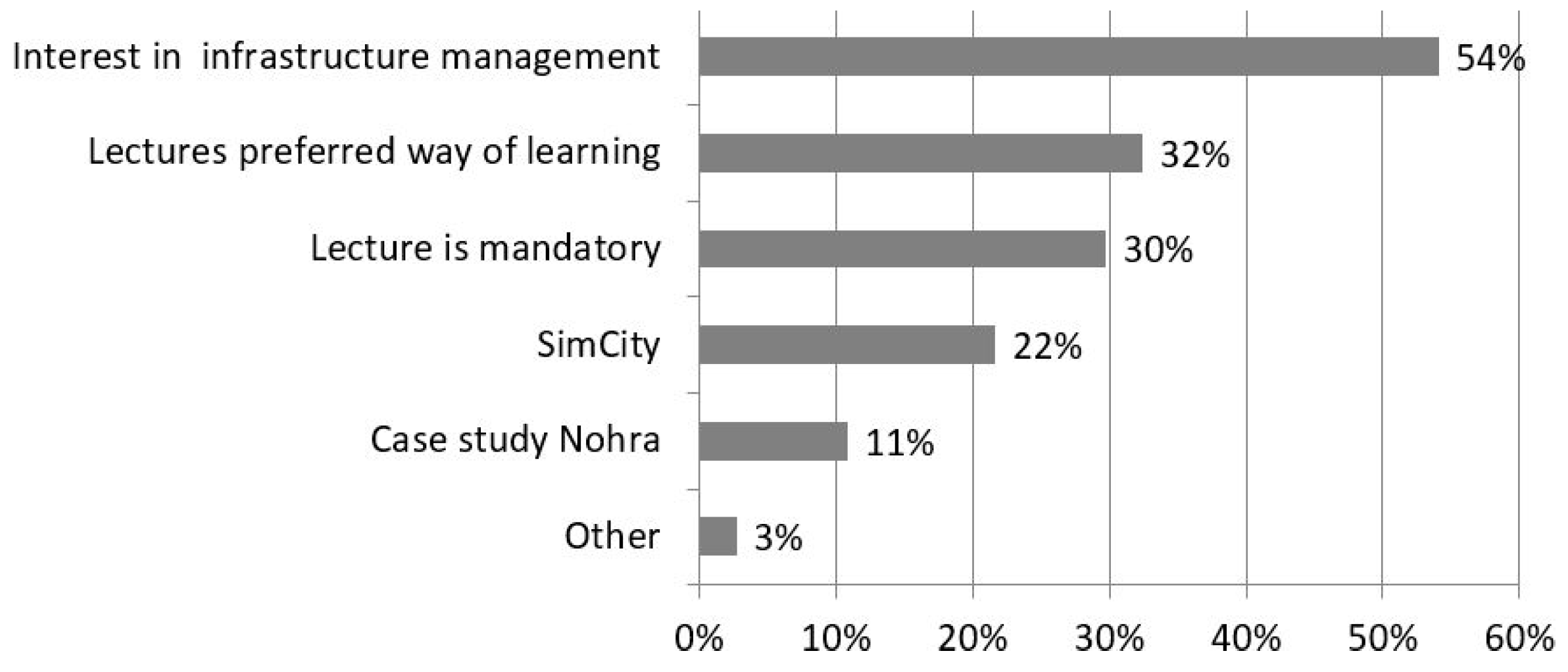


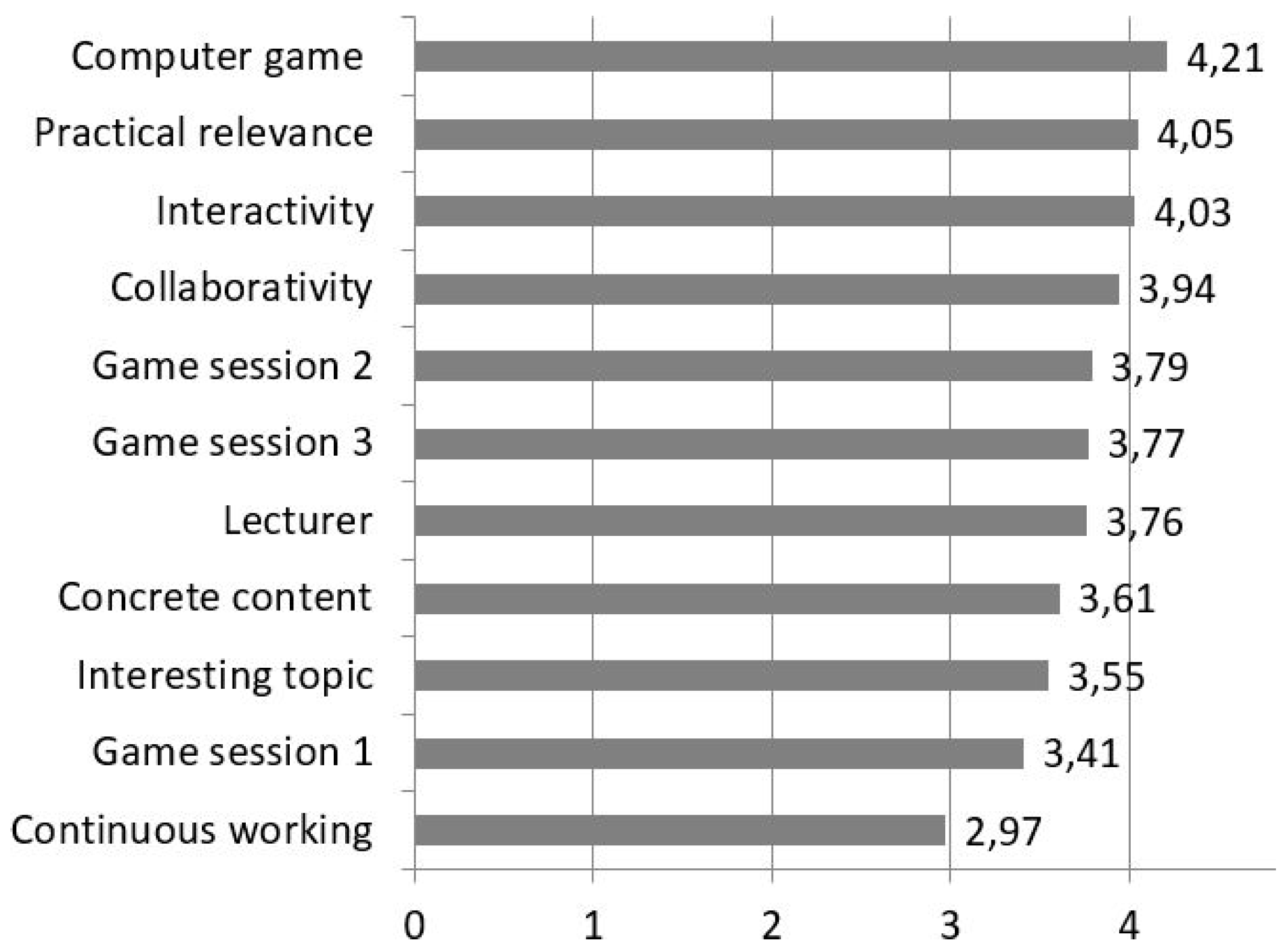
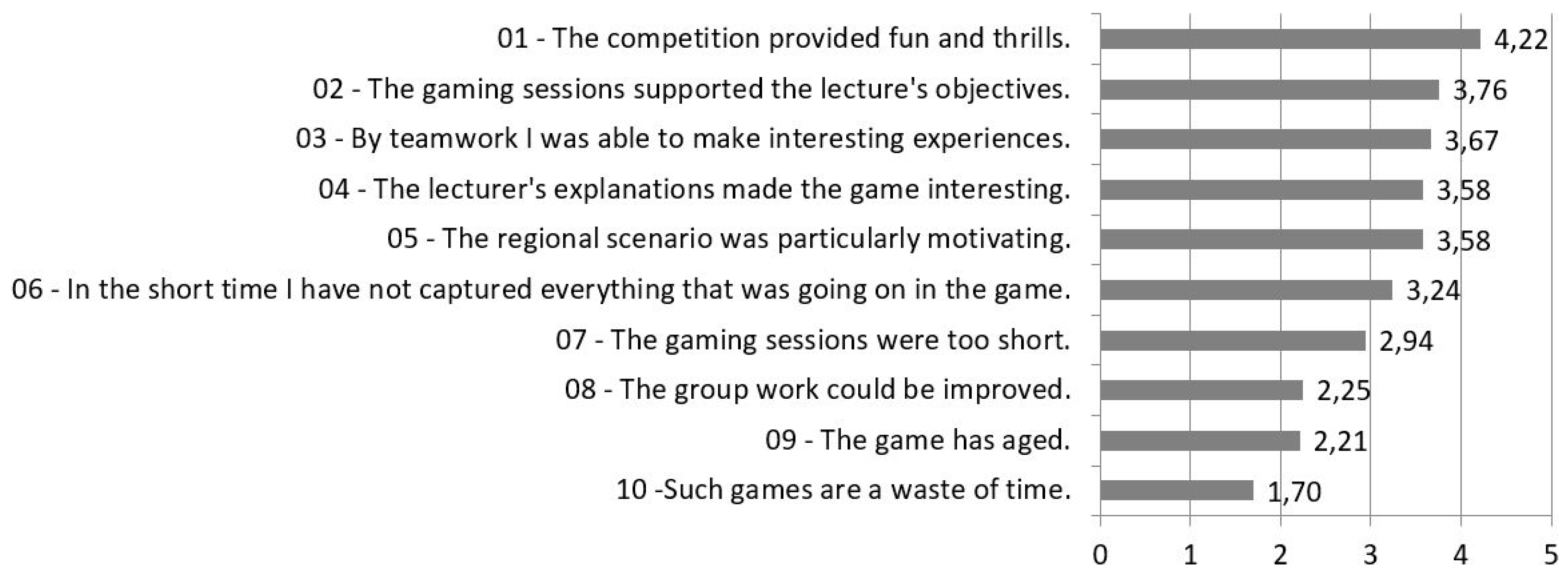
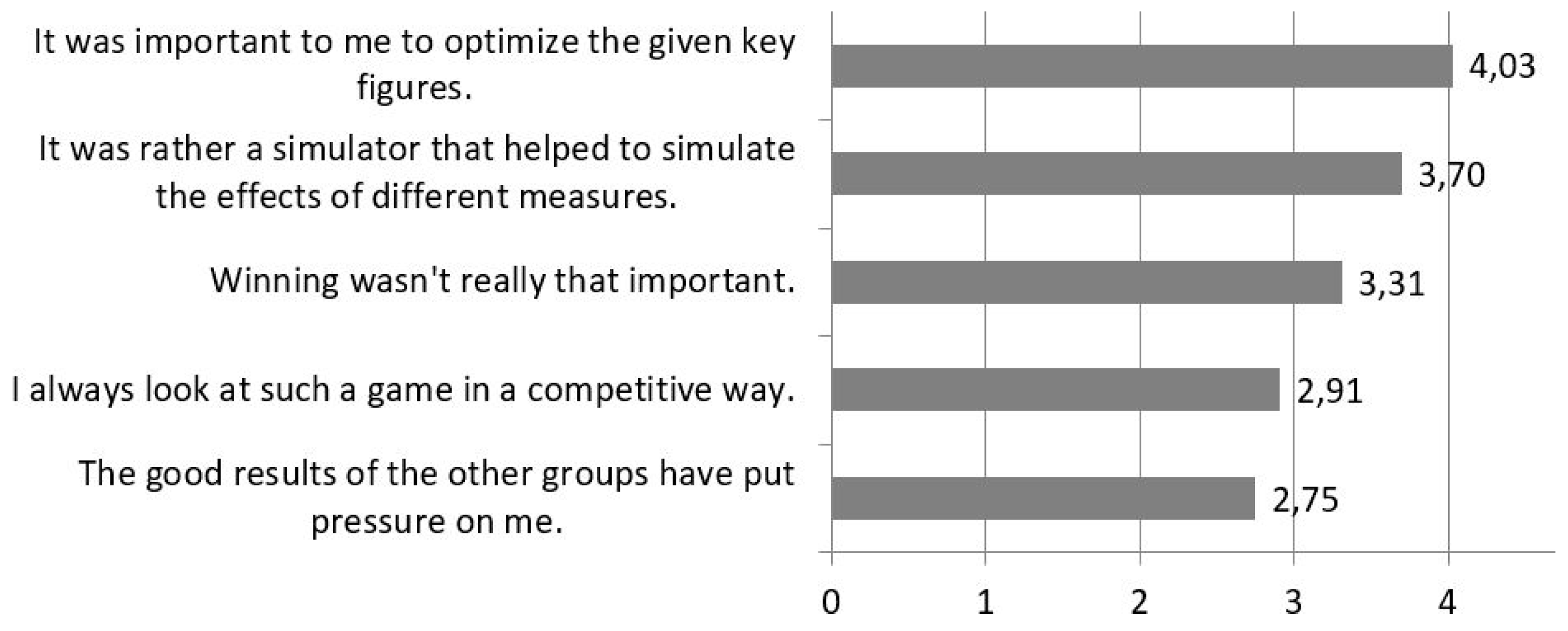
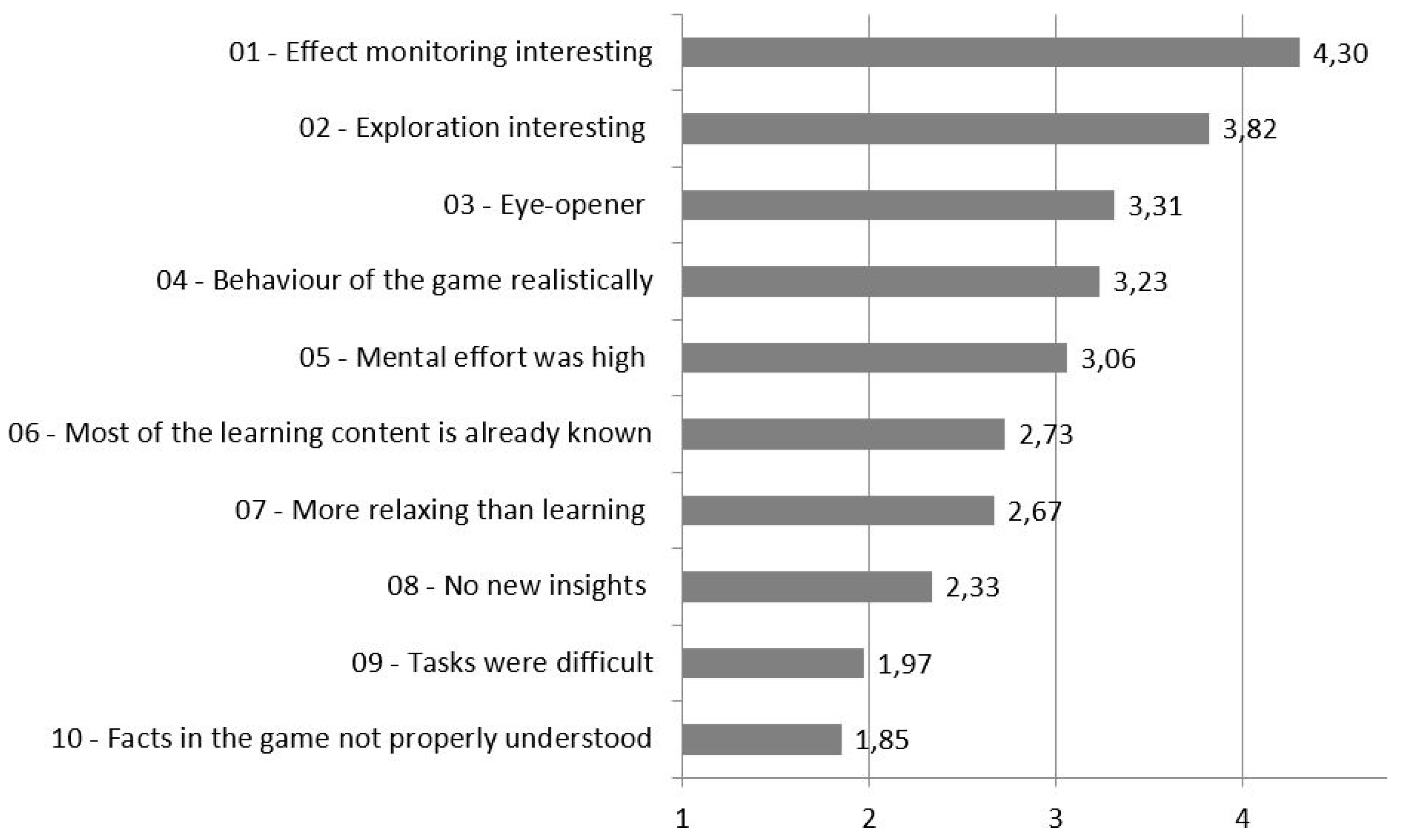

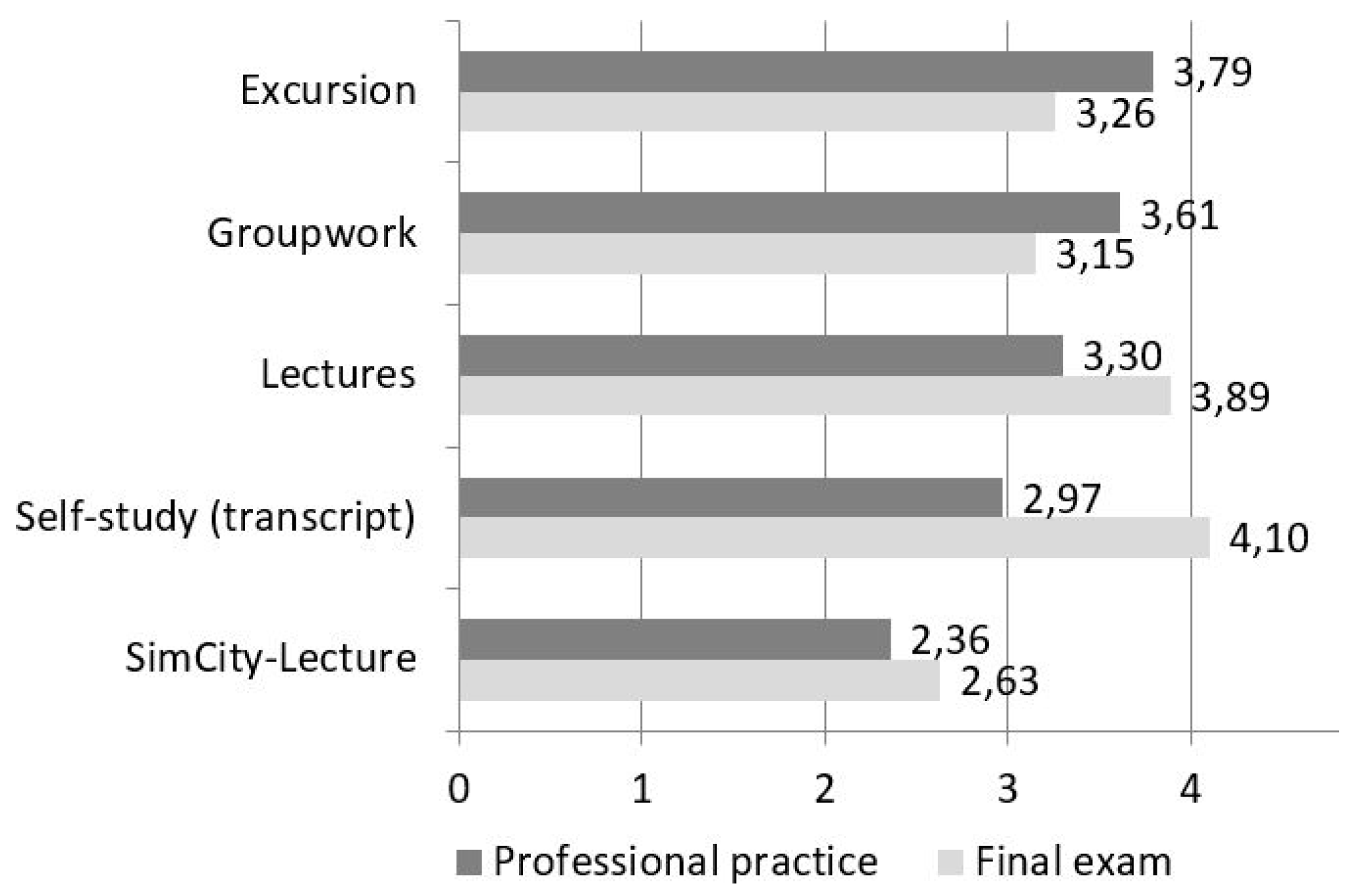
| Event | Expert Observation | Focus Group | Lecturer Interview | Questionnaire (Approx. 90 Items) | Augmented Questionnaire | n |
|---|---|---|---|---|---|---|
| 1 (2015/16) | X | 19 | ||||
| 2 (2016/17) | X | X | X | X | 7 | |
| 3 (2017/18) | X | X | X | 16 | ||
| 4 (2018/19) | X | X | X | 10 |
| Competence | Sensory and Imaginative Immersion | Flow | Tension/Annoyance | Challenge | Negative Affect | Positve Affect | IntrinsicValues | Usefulness | Importance | Challenge | Interest | ||
|---|---|---|---|---|---|---|---|---|---|---|---|---|---|
| GEQ | Competence | 1.00 | |||||||||||
| Sensory and Imaginative Imm. | 0.29 | 1.00 | |||||||||||
| Flow | 0.30 | 0.65 | 1.00 | ||||||||||
| Tension/Annoyance | −0.39 | 0.10 | 0.07 | 1.00 | |||||||||
| Challenge | 0.22 | 0.70 | 0.63 | 0.31 | 1.00 | ||||||||
| Negative Affect | −0.33 | −0.22 | −0.19 | 0.51 | 0.03 | 1.00 | |||||||
| Positve Affect | 0.60 | 0.24 | 0.24 | −0.63 | 0.06 | −0.54 | 1.00 | ||||||
| Eccles | IntrinsicValues | −0.04 | 0.64 | 0.25 | −0.16 | 0.30 | −0.09 | 0.21 | 1.00 | ||||
| Usefulness | −0.06 | 0.52 | 0.38 | −0.09 | 0.35 | −0.25 | 0.03 | 0.67 | 1.00 | ||||
| Importance | 0.06 | 0.64 | 0.33 | 0.10 | 0.33 | 0.02 | −0.01 | 0.64 | 0.61 | 1.00 | |||
| QCM | Challenge | 0.52 | 0.65 | 0.52 | −0.09 | 0.62 | −0.05 | 0.36 | 0.43 | 0.23 | 0.49 | 1.00 | |
| Interest | 0.39 | 0.51 | 0.27 | −0.09 | 0.27 | −0.11 | 0.29 | 0.20 | 0.20 | 0.49 | 0.54 | 1.00 |
© 2019 by the authors. Licensee MDPI, Basel, Switzerland. This article is an open access article distributed under the terms and conditions of the Creative Commons Attribution (CC BY) license (http://creativecommons.org/licenses/by/4.0/).
Share and Cite
Arnold, U.; Söbke, H.; Reichelt, M. SimCity in Infrastructure Management Education. Educ. Sci. 2019, 9, 209. https://doi.org/10.3390/educsci9030209
Arnold U, Söbke H, Reichelt M. SimCity in Infrastructure Management Education. Education Sciences. 2019; 9(3):209. https://doi.org/10.3390/educsci9030209
Chicago/Turabian StyleArnold, Uwe, Heinrich Söbke, and Maria Reichelt. 2019. "SimCity in Infrastructure Management Education" Education Sciences 9, no. 3: 209. https://doi.org/10.3390/educsci9030209
APA StyleArnold, U., Söbke, H., & Reichelt, M. (2019). SimCity in Infrastructure Management Education. Education Sciences, 9(3), 209. https://doi.org/10.3390/educsci9030209





